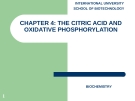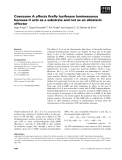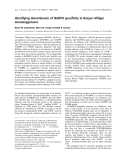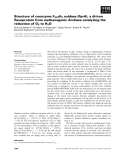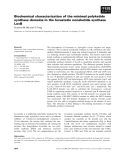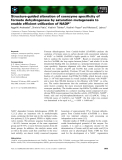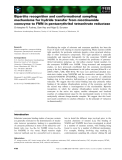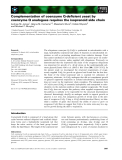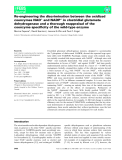
Oxidized coenzymes
-
Đây là bài giảng của thầy Đỗ Hiếu Liêm, trường ĐH Nông Lâm TP.HCM. Chuỗi hô hấp mô bào bao gồm các phản ứng oxid hoá khử liên tục trên các cơ chất (sản phẫm biến dưỡngtrung gian - Chu trình Krebs và β oxid hoá acid béo). Tổ chức: hệthống enzyme CHH với các coenzyme tổchức thành từng tổ hợp và sắp xếp theo thứ tự tăng dầnđiện thế oxid hoá khử,bắđầu NAD+ dehydrogenase có điện thế âm và cuối cùng là cytochrome oxidase có điện thế dương....
 32p
32p  h08112107
h08112107
 22-08-2010
22-08-2010
 326
326
 134
134
 Download
Download
-
Early metabolic steps, including glycolysis and the activity of the pyruvate dehydrogenase complex, yield a two-carbon fragment called an acetyl group, which is linked to a large cofactor known as coenzyme A (or CoA). It is during the citric acid cycle that acetyl-CoA is oxidized to the waste product, carbon dioxide, along with the reduction of the cofactors NAD+ and ubiquinone
 94p
94p  zingzing09
zingzing09
 21-10-2012
21-10-2012
 59
59
 9
9
 Download
Download
-
The effect of CoA on the characteristic light decay of the firefly luciferase catalysed bioluminescence reaction was studied. At least part of the light decay is due to the luciferase catalysed formation of dehydroluciferyl-adenylate (L-AMP), a by-product that results from oxidation of luciferyl-adenylate (LH2-AMP), and is a powerful inhibitor of the bioluminescence reaction (IC50¼6nm).
 11p
11p  fptmusic
fptmusic
 12-04-2013
12-04-2013
 40
40
 4
4
 Download
Download
-
The roles of His181, His184 and Tyr186 in PETN reductase have been examined by mutagenesis, spectroscopic and stopped-flow kinetics, and by determination of crystallographic structures for the Y186F PETN reductase and reduced wild-type enzyme—progesterone complex. Residues His181 and His184 are important in the binding of coenzyme, steroids, nitro-aromatic ligands and the substrate 2-cyclohexen-1-one.
 12p
12p  fptmusic
fptmusic
 12-04-2013
12-04-2013
 41
41
 3
3
 Download
Download
-
The Baeyer–Villiger monooxygenase (BVMO), 4-hydroxy-acetophenone monooxygenase (HAPMO), uses NADPH andO2 to oxidize a variety of aromatic ketones and sulfides. The FAD-containing enzyme has a 700-fold preference for NADPH over NADH. Sequence alignment with other BVMOs, which are all known to be selective for NADPH, revealed three conservedbasic residues,whichcouldaccount for the observed coenzyme specificity. The corresponding residues in HAPMO (Arg339, Lys439 and Arg440) were mutated and the properties of the purified mutant enzymes were studied. ...
 10p
10p  dell39
dell39
 03-04-2013
03-04-2013
 29
29
 2
2
 Download
Download
-
The functional activities of proteins are closely related to their molecular structure and understanding their structure–function relationships remains one of the intriguing problems of molecular biology. We investigated struc-tural changes in 17b-hydroxysteroid dehydrogenase from the fungus Cochliobolus lunatus(17b-HSDcl) induced by pH, temperature, salt, urea, guanidine hydrochloride, and coenzyme NADPH binding.
 11p
11p  inspiron33
inspiron33
 25-03-2013
25-03-2013
 44
44
 4
4
 Download
Download
-
The di-iron flavoprotein F420H2 oxidase found in methanogenic Archaea catalyzes the four-electron reduction of O2to 2H2O with 2 mol of reduced coenzyme F420(7,8-dimethyl-8-hydroxy-5-deazariboflavin). We report here on crystal structures of the homotetrameric F420H2 oxidase fromMethan-othermobacter marburgensis at resolutions of 2.25 A ˚ , 2.25 A ˚ and 1.7 A ˚ , respectively, from which an active reduced state, an inactive oxidized state and an active oxidized state could be extracted.
 12p
12p  galaxyss3
galaxyss3
 21-03-2013
21-03-2013
 45
45
 4
4
 Download
Download
-
The biosynthesis of lovastatin inAspergillus terreusrequires two mega-synthases. The lovastatin nonaketide synthase, LovB, synthesizes the inter-mediate dihydromonacolin L using nine malonyl-coenzyme A molecules, and is a reducing, iterative type I polyketide synthase.
 11p
11p  galaxyss3
galaxyss3
 19-03-2013
19-03-2013
 35
35
 5
5
 Download
Download
-
Formate dehydrogenase from Candida boidinii(CboFDH) catalyses the oxidation of formate anion to carbon dioxide with concomitant reduction of NAD + to NADH. CboFDH is highly specific to NAD + and virtually fails to catalyze the reaction with NADP + . Based on structural informa-tion for CboFDH, the loop region betweenb-sheet 7 and a-helix 10 in the dinucleotide-binding fold was predicted as a principal determinant of coen-zyme specificity.
 11p
11p  galaxyss3
galaxyss3
 07-03-2013
07-03-2013
 29
29
 3
3
 Download
Download
-
Glutamate dehydrogenase (EC 1.4.1.2–4) fromPeptostreptococcus asacch-arolyticushas a strong preference for NADH over NADPH as a coenzyme, over 1000-fold in terms ofkcat ⁄Kmvalues. Sequence alignments across the wider family of NAD(P)-dependent dehydrogenases might suggest that this preference is mainly due to a negatively charged glutamate at position 243 (E243) in the adenine ribose-binding pocket.
 8p
8p  media19
media19
 04-03-2013
04-03-2013
 39
39
 3
3
 Download
Download
-
Elucidating the origin of substrate and coenzyme specificity has been the focus of much work relating to enzyme engineering. Many enzymes exhibit tight specificity for particular substrates despite a close structural relation-ship to other nonreactive compounds.
 10p
10p  vinaphone15
vinaphone15
 25-02-2013
25-02-2013
 38
38
 3
3
 Download
Download
-
The ubiquinone coenzyme Q (CoQ) is synthesized in mitochondria with a large, hydrophobic isoprenoid side chain. It functions in mitochondrial res-piration as well as protecting membranes from oxidative damage. Yeast that cannot synthesize CoQ (DCoQ) are viable, but cannot grow on nonfer-mentable carbon sources, unless supplied with ubiquinone.
 16p
16p  mobifone23
mobifone23
 21-01-2013
21-01-2013
 25
25
 4
4
 Download
Download
-
Clostridial glutamate dehydrogenase mutants, designed to accommodate the 2¢-phosphate of disfavoured NADPH, showed the expected large speci-ficity shifts with NAD(P)H. Puzzlingly, similar assays with oxidized cofac-tors initially revealed little improvement with NADP + , although rates with NAD + were markedly diminished.
 9p
9p  cosis54
cosis54
 05-01-2013
05-01-2013
 50
50
 4
4
 Download
Download
CHỦ ĐỀ BẠN MUỐN TÌM










